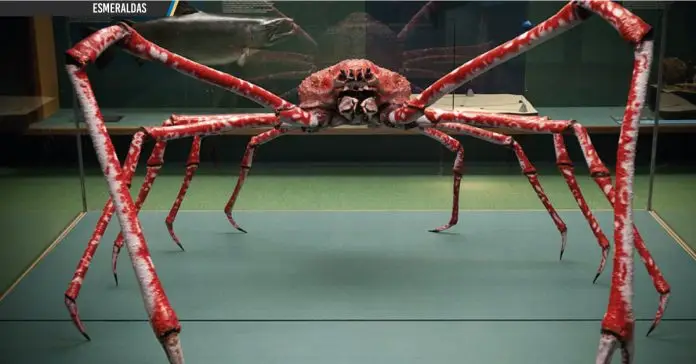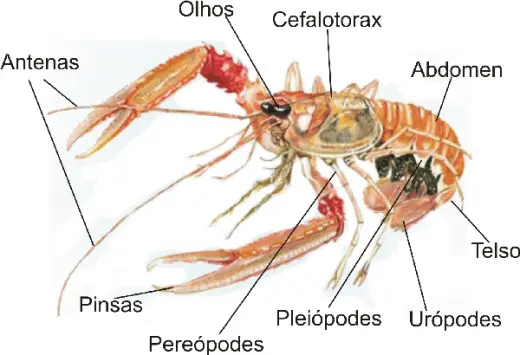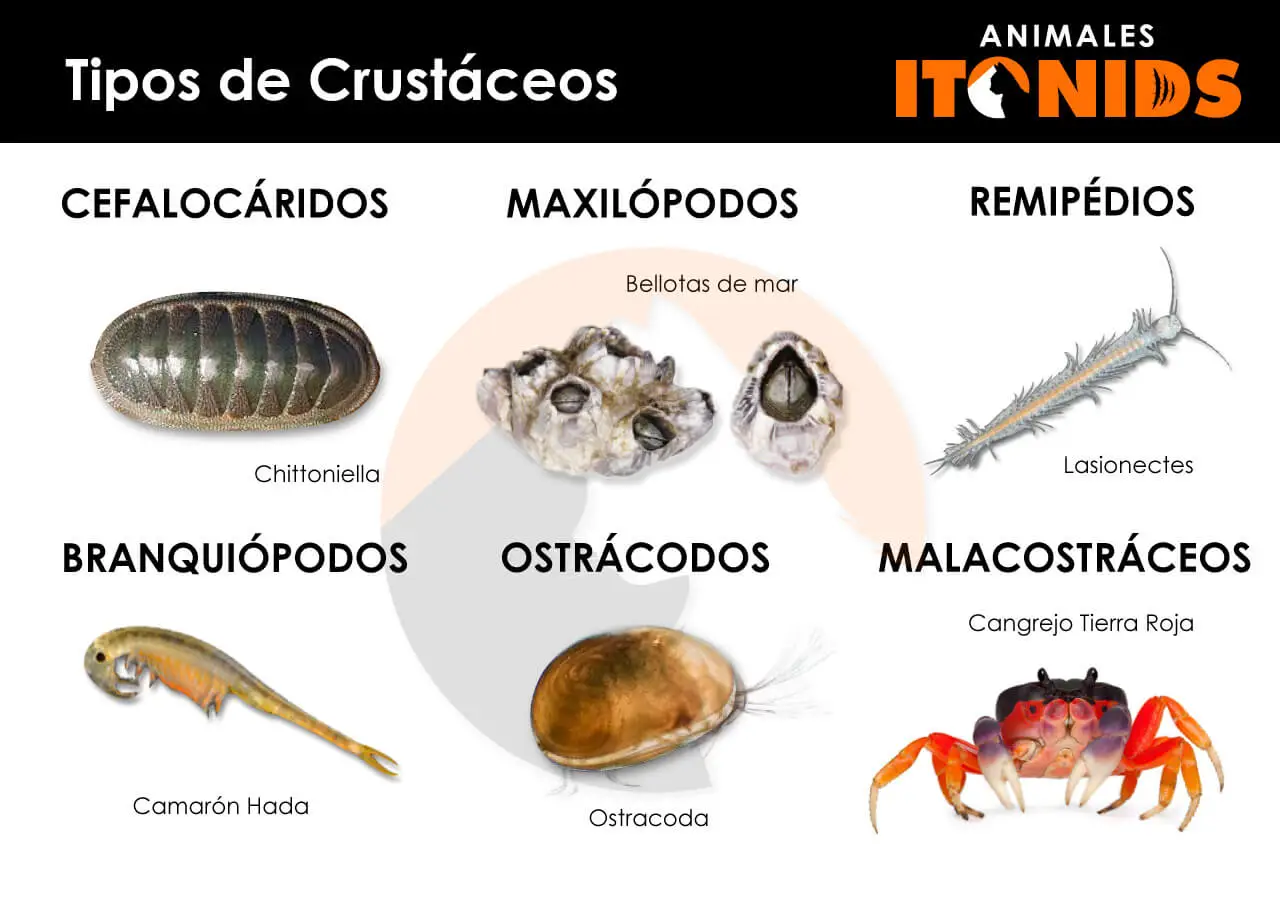In the depths of the sea, underground waters (below the surface of the earth), rivers, lakes, and even on land (moist places), it is possible to find some representative of this curious family of animals called “Crustaceans”
Who has not ventured to follow a crab on the shore of the beach and see its peculiar walk and its fantastic claws?
Crabs, shrimps, lobsters… are examples of well-known crustaceans (with a great variety of shapes and sizes) with a common characteristic: a body covered by a shell or shell, hence its name (“crusta”, crust or bark).
With more than 67,000 known species of crustaceans! Distributed all over the world, and served as exquisite dishes in the most famous kitchens, these animals exhibit unique and even amusing characteristics.
Discover each one of them, the parts of their body, where they live, types of crustaceans, and more…
What are Crustaceans?
They are a very diverse group of invertebrate animals (without a spinal column), classified as “Arthropods” for having legs divided into pieces that move (articulated) and “Crustaceans” for having a shell or shell (generally hard) that protects them.
Among them are: The river and sea crab, the spider crab, the lobster, prawns, shrimps, krill, velvet crabs, barnacles, water fleas, and woodlice… both in fresh water and in salt water, and they are of great ecological importance.
Meaning of Crustaceans
The word crustaceans, comes from “Crustacea, from Latin “crusta”, which means ‘crust’ and “aceum”, ‘nature of something’”, that is, it is characterized by having its body covered or safeguarded by a shell or crust.
Hence its name is related to one of the main characteristics of this species.
Previously, characters like Aristotle used the word “Malacostraca, from the Greek “malakos”, which translates as ‘soft’ and “ostrakos” meaning ‘shell’” or soft-shelled animals, to differentiate them from mollusks (hard-shelled).
Currently, this name includes the superior or larger crustaceans.
Did you know…? From the shell of crustaceans, chitin and chitosan (natural polymers) are obtained, which are very useful at the industrial level (medicine, pharmacy, food, agriculture…)
Characteristics of Crustaceans
They possess articulated (mobile) legs used for pressing and moving. The number of legs varies (always in even numbers), the most common being, five pairs of legs.
They have an exoskeleton (external skeleton) in the form of a shell or shell, which can be hard or flexible, composed of chitin (a protein) and mineral salts.
Their body is divided into three parts (or tagmas): head (cephalon), thorax (pereion), and abdomen (pleon).
They show bilateral symmetry (if you draw a line in the middle of their body, you will notice that it is divided into two equal halves) and their shape can be flattened or circular.

Their size varies (according to the species) and ranges from microns (very small length) like the “water flea”, to four meters (Japanese spider crab).
Males are (almost always) slightly smaller and have bright colors (orange, red, green, blue).
They are the only arthropods that possess two pairs of antennas.
They have three pairs of masticatory pieces (maxillipeds).
Most of their legs or appendages are biramous, that is, they are divided into two parts or branches, separated in turn, by smaller pieces (articles).
On average, they can live between 4 and 12 years.
Did you know…? Species like the Japanese giant crab can live up to 100 years.

Parts of the Crustaceans
The head and thorax may join together, fused into a single piece called the “cephalothorax”; in others, the abdomen and thorax join to form the trunk; from there, various articulated legs (or appendages) extend.
In the head are located the brain, a pair of compound eyes on a sort of branch or very thin tube (called peduncles) and five pairs of appendages: antennules, antennas, mandibles, maxillules, and maxillae, surrounding the mouth. Certain species lack eyes.
The antennules (small antennas) and antennas (longer) contain tiny threads (called flagella) that make them sensitive to touch. The mandibles, maxillules, and maxillae (chewing pieces) serve to hold prey, crush it, and carry it to the mouth.

In the thorax, there are other articulated legs (varying between 4 and 120, depending on the species), known as “pereiopods,” responsible for movement, defense, and respiration functions. Sometimes, the first appendages function as chewing pieces.
The segmented abdomen (divided) of crustaceans, has “pleopods” or pairs of legs (in each division), and ends in a piece called the telson and the “uropods” (final legs, which include the anus) forming a useful structure for swimming (fan-shaped).
Additionally, in females, these appendages serve to retain the egg sac and are involved in reproduction. Some species seek the shell of a snail to place their soft abdomen.
Did you know? Hermit crabs (from the genus Paguropsis) instead of seeking snail shells to protect their rear, prefer to place a sea anemone on their body as if it were a sheet and take advantage of its provisions.
Digestive System
The digestive system of crustaceans consists of a straight tube, running the length of their body, divided into three parts: the stomodeum, which connects the mouth to the stomach through the pharynx; the mesodeum, which includes the intestine; and the proctodeum, which ends in the anus.
Some crustaceans (like the crab) have a small organ that acts as a stomach grinder.
Nervous System
The more developed crustacean species (decapods) have sensory organs all over their body (compound eyes, sound receptors, temperature changes, water vibrations…) that transmit information to the brain via a central nerve cord.
Circulatory System
The circulatory system of crustaceans is arterial.
The heart (located in the cephalothorax) pumps a fluid (called hemolymph) that contains nutrient substances, and connects with an internal cavity (hemocoel), distributing the fluid through arteries to the tissues (like an open network).
The heart may be elongated or rounded in shape. Some species have pigments that carry oxygen (hemocyanin).
Respiratory System
The respiration of crustaceans is branchial; depending on the species, water enters the gills (respiratory organs on each side of the cephalothorax) from different places, and through their walls, captures the oxygen contained in the water.
In their gills, they have filtering or cleaning bristles, which prevent the entry of foreign particles.
Certain small crustacean species can breathe through their skin (cutaneous respiration), and others (crabs) can breathe out of water through tracheas (tubes) that keep their gills moist.
Excretory System
The elimination of wastes in crustaceans occurs by collecting wastes in sacs located beneath the antennas (antennal glands); wastes are eliminated through orifices (excretory pore) located on their head.
Certain terrestrial species (isopods) are capable of excreting nitrogen through the body walls.
Muscular System
The muscles of crustaceans are striated, and form filaments (grouped in clusters) called myofibrils; which may act slowly or quickly, depending on the action (contraction) to be performed during a stimulus.
Reproduction of Crustaceans
Generally, the reproduction of crustaceans is sexual; females and males are distinguished; and depending on the species, it can occur through internal or external fertilization.
The male connects his spermatophore (sac containing sperm) to the female’s receptive organ, joining their bellies and leading to internal fertilization. Then, the eggs are released into the water or carried on their body, and cared for with great caution.
The development of crustaceans is indirect: from the egg emerges a larval form (nauplius) that transforms into an adult through various phases or changes (metamorphosis) and grows by shedding its shell to give life to a new one.
Other species (shrimps) reproduce by hatching (breaking of the egg) that leads to a new individual with characteristics similar to the adult.
There are also hermaphroditic species (barnacles) (having both sexes) that can reproduce by themselves.
Did you know? To court the female, the crab (Uca pugnax) builds a tunnel as a burrow and exchanges glances to attract her, incorporating movements with its legs simulating playing a violin; if the female accepts, she will follow it into the tunnel for mating.
Where do crustaceans live?
Crustaceans dominate aquatic environments and can be found all over the world at any depth, both in the sea (in greater numbers) and in rivers, lakes, streams, and groundwater wells (cenotes), living freely, anchored to floating objects or fixed onto rocks.
Only a few species have adapted to terrestrial ecosystems (isopods), and it is necessary for them to retain moisture in their gills to breathe; therefore, they live in the soil in humid environments.
What do crustaceans eat?
Their diet varies; primarily, they are carnivorous (predators), others are exclusively herbivorous (feeding on plants and algae); there are species that feed on organic matter floating in the water (detritus) or on dead animals (scavengers).
There are also parasitic species that live in a host and consume a percentage of their host’s food, and finally, there are species that consume everything.
Types of crustaceans
The subphylum “Crustacea” can be divided into six major classes, which group various species:

Class Cephalocarida (Cephalocarids)
Crustaceans that inhabit ocean floors, elongated and very small (their size barely reaches 4 millimeters), lack eyes, and their body is primitive.
Species: Sandersiella, Hampsonellus, Chittoniella.
Class Branchiopoda (Branchiopods)
Typical of freshwater ecosystems (rivers, lakes, streams) and characterized by their laminar head and an appendage behind their head.
Species: Fairy shrimp, tadpole shrimp, clam shrimp, water flea.
Class Ostracoda (Ostracods)
Crustaceans that live in all aquatic environments, on algae or marine plants; microscopic in size, characterized by their shell or carapace that covers their entire body.
Species: Cypris, Candona, Manawa, Conchoecia, seed shrimp.
Class Maxillopoda (Maxillopods)
Marine crustaceans, fixed to rocks, in shallow areas, or forming part of the zooplankton; generally recognized by their small bodies, mainly by their reduced abdomen and for not having all their legs.
Species: Barnacles, acorn barnacles, cirripedes, fish lice.
Class Remipedia (Remipedes)
Tiny crustaceans native to deep sea caves, without eyes, and their maxillae (chewing parts) can inject venom.
Species: Godzillius, Lasionectes, Pleomothra, blind shrimp.
Class Malacostraca (Malacostracans)
Represents the class that groups the largest number of species and with the most well-known representatives, especially the Decapoda group (crustaceans with ten legs); they inhabit all aquatic environments, including terrestrial ones.
Species: Lobsters, crayfish, crabs, shrimp, amphipods, isopods (woodlice), mantis shrimp.

Examples of crustaceans
Mole crab (Emerita talpoida)
A crustacean belonging to the “Decapods” order of the “Malacostraca” class with a wide and oval body; it lives on almost all the beaches of the world and is specially adapted to burrow in moist sand.
The female is larger and can lay up to 45,000 eggs grouped in an orange mass under her abdomen.
It moves with the tide, buries itself in the sand backwards (facing the sea), and remains with half its body out, at the water’s edge, leaving its antennae extended to collect plankton and organic remains from the water.
Skeleton shrimp (Liropus minusculus)
An amazing marine crustacean, belonging to the “Amphipods” order of the “Malacostraca” class, it is named for its completely transparent body and lack of much flesh.
It was discovered in 2012 in California, United States, and is also associated with the seas of Japan.
Tiny in size (about 3 millimeters), the male is larger than the female, and it reproduces quickly; its diet and other characteristics are subjects of study.
Importance of crustaceans
They play an important role ecologically (serving as food for other marine species); and because they are very sensitive to environmental changes in their surroundings, they serve as bioindicators of pollution.
They are also of great economic importance, as certain species (crabs, lobsters, shrimp) are edible crustaceans, consumed by humans and considered exotic dishes.
Did you know? Recently, the government of Switzerland ordered that lobsters and other crustaceans not be introduced alive into boiling water, as studies are being conducted that indicate they can feel pain.
Frequently asked questions
The freshwater and marine crab, the spider crab, the lobster, prawns, shrimp, krill, velvet crabs, acorn barnacles, barnacles, water fleas, and woodlice.
Class Cephalocarida (Cephalocarids), Class Branchiopoda (Branchiopods), Class Ostracoda (Ostracods), Class Maxillopoda (Maxillopods), Class Remipedia (Remipedes), Class Malacostraca (Malacostracans).

The number of legs varies (always in pairs), with the most common being five pairs of legs.

